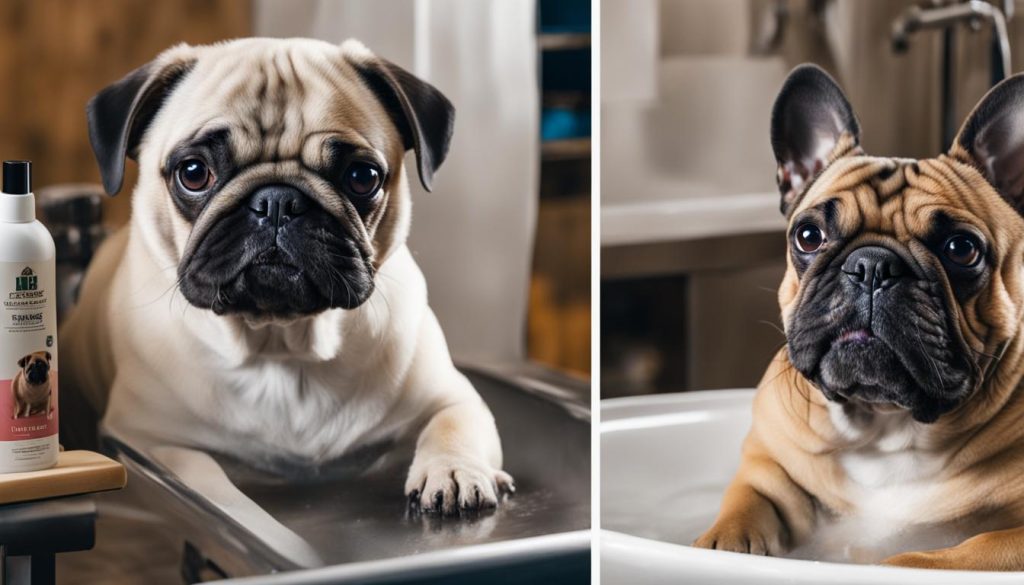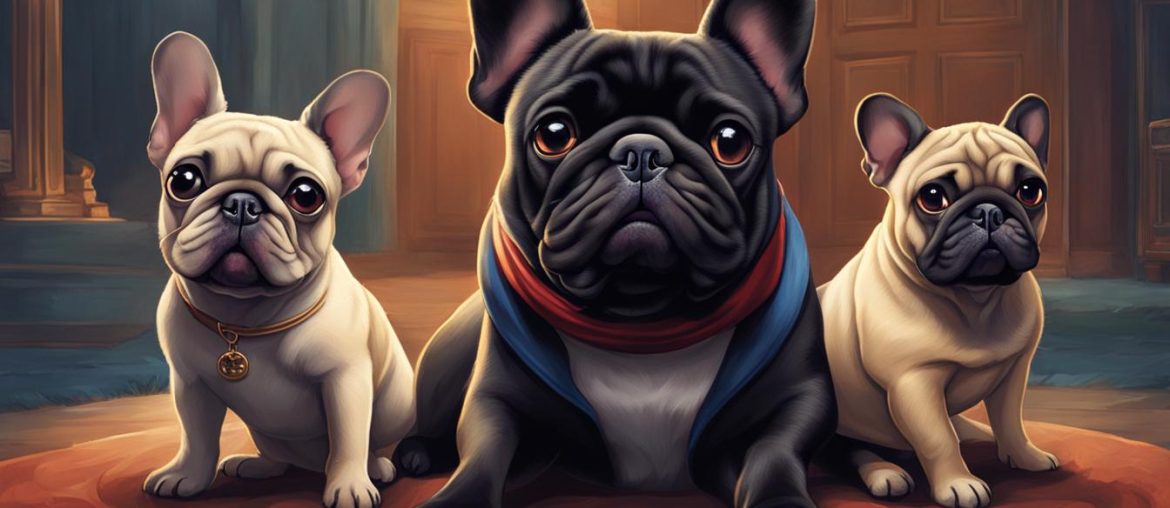When it comes to choosing a new furry companion, the debate between Pugs and French Bulldogs has become a hot topic. As a pet owner, I would advise that you make an informed decision that takes into account various factors. Both breeds have their unique qualities and potential health concerns, making the choice between a Pug and a French Bulldog a personal one.
In the Netherlands, the potential ban on flat-faced dog breeds has sparked discussions about the ethics of owning Pugs and French Bulldogs. The health issues associated with these breeds have brought the topic to the forefront. In this article, I will delve into the differences between Pugs and French Bulldogs, aiming to provide you with the information you need to make the best decision for your lifestyle and preferences.
Key Takeaways:
- Consider the potential health issues associated with Pugs and French Bulldogs before making a decision.
- Both breeds have different sizes and appearances, so choose based on your preference.
- Take into account the temperament and personality traits of each breed, as it affects compatibility with your lifestyle.
- Evaluate the exercise needs and grooming requirements of both breeds to see what aligns with your capabilities.
- Consider the living conditions and training requirements for Pugs and French Bulldogs.
Health Considerations
When considering a Pug or a French Bulldog as a pet, it is good practice to understand the potential health considerations associated with these breeds. Both Pugs and French Bulldogs are susceptible to certain health issues due to their flat faces and body structure. Pugs often experience respiratory problems, such as difficulty breathing and snoring, caused by their narrowed airways. Similarly, French Bulldogs also face breathing difficulties due to their brachycephalic faces.
In addition to respiratory issues, both breeds are prone to skin fold dermatitis, allergies, and other health concerns. You should be aware of these potential health issues and be prepared to provide the necessary care and attention for your chosen breed. Regular visits to the veterinarian, proper nutrition, and maintaining a healthy weight are essential in ensuring the overall well-being of your Pug or French Bulldog.
| Health Considerations | Pug | French Bulldog |
|---|---|---|
| Respiratory Issues | Difficulty breathing, snoring | Breathing difficulties |
| Skin Fold Dermatitis | Prone to skin fold dermatitis | Prone to skin fold dermatitis |
| Allergies | Possible allergies | Possible allergies |
By understanding and addressing these health considerations, you can ensure that your Pug or French Bulldog lives a happy and healthy life. Regular veterinary check-ups, a balanced diet, and proper care will help minimize the potential risks and ensure that your furry companion enjoys a high quality of life.
Size and Appearance
When considering a Pug or a French Bulldog as your furry companion, one crucial aspect to take into account is their size and appearance. These two breeds have distinct differences that can influence your decision.
Starting with size, Pugs are generally smaller and more compact, weighing between 14-18 pounds. They have a round head, deep wrinkles, and a curled tail, giving them an adorable and distinctive look. On the other hand, French Bulldogs are slightly larger and more muscular, weighing between 16-28 pounds. They have a square-shaped head, bat-like ears, and a straight tail. Their strong physique exudes a sense of confidence and charm.
Visually, both breeds offer unique and endearing characteristics that may appeal to different individuals. Some may prefer the cute and compact size of a Pug, while others may be drawn to the muscular and sturdy appearance of a French Bulldog. It ultimately comes down to personal preference and what resonates with you.

Giving more relevance to size and appearance
When it comes to size, consider your living situation and available space. If you reside in a smaller apartment or prefer a more portable dog, the Pug’s smaller size may be a better fit. However, if you have a larger living space or prefer a dog with a more substantial presence, the French Bulldog’s size might be more suitable for you.
Aside from size, appearance plays a role in the overall aesthetic of your chosen breed. If you are charmed by the Pug’s wrinkled face and curly tail, or if the straight tail and bat-like ears of the French Bulldog capture your heart, these distinctive features should factor into your decision-making process.
| Size and Appearance | Pug | French Bulldog |
|---|---|---|
| Weight | 14-18 pounds | 16-28 pounds |
| Head Shape | Round | Square |
| Ear Shape | N/A | Bat-like |
| Tail Shape | Curled | Straight |
As you explore the differences in size and appearance, take into consideration your own preferences and what resonates with you. Whether you are captivated by the compact cuteness of a Pug or the sturdy charm of a French Bulldog, choosing the right breed based on size and appearance is an integral part of finding the perfect furry companion.
Temperament and Personality
When it comes to temperament and personality, Pugs and French Bulldogs have distinct differences that can greatly influence your decision in choosing the right breed for you. Pugs are known for their friendly and easygoing nature. They are often described as social butterflies and get along well with children and other pets. Their charming and affectionate personality makes them excellent companions.
On the other hand, French Bulldogs are also known for their affectionate nature but have a slightly more playful and energetic temperament compared to Pugs. They are known to be great companions and adapt well to different living situations. French Bulldogs are also highly regarded for their loyalty and love for their owners.
When considering the temperament and personality of these breeds, it is essential to evaluate your own lifestyle and preferences. If you are looking for a friendly and social dog who gets along well with everyone, a Pug might be the best choice for you. However, if you prefer a slightly more energetic and playful companion who is equally affectionate, a French Bulldog could be the perfect fit.
Key Differences in Temperament and Personality:
- Pugs: Friendly, charming, easygoing, social butterflies.
- French Bulldogs: Affectionate, playful, adaptable, loyal.
To put it simply, each dog is an individual, and there can be variations in temperament even within the same breed. You should spend time with both Pugs and French Bulldogs to get a better understanding of their unique personalities and ensure a good match between you and your future furry companion.

Exercise Needs
When it comes to exercise needs, both Pugs and French Bulldogs have relatively low requirements compared to some other dog breeds. Pugs are known for being less active and may prefer shorter walks and play sessions. French Bulldogs also do not require excessive exercise and can be satisfied with moderate activity levels. However, you should provide regular exercise and mental stimulation for both breeds to maintain their overall health and wellbeing.
While Pugs and French Bulldogs may not need long daily walks or intense exercise routines, it is still essential to incorporate regular physical activity into their daily lives. This can be achieved through short walks around the neighborhood, playtime in a fenced yard, or interactive indoor games. You should note that both breeds are prone to weight gain, so monitoring their diet and exercise levels is crucial to prevent obesity, which can lead to various health issues.
Additionally, mental stimulation is just as important as physical exercise for both Pugs and French Bulldogs. These breeds thrive on mental challenges and enjoy activities that engage their minds. Interactive toys, puzzle games, and obedience training sessions can help keep them mentally sharp and prevent boredom. You should provide a variety of stimulating activities to keep them entertained and prevent destructive behavior.
| Breed | Exercise Needs |
|---|---|
| Pug | Low to moderate exercise needs |
| French Bulldog | Low to moderate exercise needs |
Overall, both Pugs and French Bulldogs are well-suited for individuals or families with a more laid-back lifestyle. While they may not require excessive exercise, you should provide regular physical activity and mental stimulation to keep them happy and healthy. Consider your own activity level and lifestyle when deciding which breed would be the best fit for you.
Grooming Requirements
When it comes to grooming requirements, Pugs and French Bulldogs have some distinct differences. Pugs have a short and smooth coat that requires minimal maintenance. Regular brushing to remove loose hair and occasional baths to keep them clean and smelling fresh are usually sufficient. However, attention should be paid to cleaning and drying their facial wrinkles to prevent infections.
On the other hand, French Bulldogs have a short, dense coat that requires more attention. Regular brushing is necessary to prevent shedding and keep their coat looking neat. They also benefit from occasional baths to maintain their hygiene. Additionally, like Pugs, French Bulldogs also need special care for their facial wrinkles to prevent skin issues.
I recommend that you consider your preferences and lifestyle when deciding between these breeds. If you prefer a breed with lower grooming needs, a Pug may be the right choice for you. However, if you’re willing to invest more time in grooming and care, a French Bulldog could be a great companion.

| Grooming Requirements | Pug | French Bulldog |
|---|---|---|
| Coat | Short and smooth | Short and dense |
| Brushing | Regular brushing to remove loose hair | Regular brushing to prevent shedding |
| Baths | Occasional baths to keep clean | Occasional baths for hygiene |
| Facial Wrinkles | Attention needed for cleaning and drying | Special care to prevent skin issues |
Living Conditions
When considering whether to bring a Pug or a French Bulldog into your home, take into account their living conditions. Both breeds can adapt well to various environments and are suitable for apartment living. However, please provide them with a comfortable living space and proper socialization to ensure their happiness and well-being.
Pugs and French Bulldogs do not require excessive exercise and have relatively low energy levels compared to some other dog breeds. This makes them an excellent choice for individuals or families with a less active lifestyle. while they don’t need a lot of physical activity, mental stimulation through playtime and interactive toys is essential to keep them mentally sharp and prevent boredom.
Creating a designated space in your home for your Pug or French Bulldog is also crucial. Both breeds are known to be territorial and appreciate having a spot they can call their own. Providing a comfortable bed, toys, and a safe area where they can retreat to will help them feel secure and content in their living environment.
Living Conditions Checklist
- Provide a comfortable living space, such as a designated bed or area in your home
- Ensure your home is safe and secure for your pet, with no hazards or potential dangers
- Provide mental stimulation through playtime and interactive toys
- Create a routine that includes regular feeding times, exercise, and socialization
- Consider the size of your living space and whether it can accommodate the needs of your chosen breed
By considering these factors and providing a suitable living environment, you can ensure that both Pugs and French Bulldogs thrive and live a happy, healthy life as part of your family.

Training and Socialization
Training and socialization are crucial aspects of owning a Pug or a French Bulldog. Both breeds are generally eager to please their owners, making them trainable with positive reinforcement methods. However, French Bulldogs may have a stubborn streak and require consistent and patient training.
When it comes to socialization, both breeds benefit greatly from early and ongoing exposure to various people, animals, and environments. This helps them develop good manners, confidence, and a positive attitude towards new experiences. Socialization should be a priority from a young age to ensure that your Pug or French Bulldog grows up to be a well-rounded and friendly companion.
Training Tips:
- Start training your Pug or French Bulldog from an early age to establish good behaviors and basic commands.
- Use positive reinforcement techniques such as treats, praise, and playtime to motivate your dog.
- Be patient and consistent in your training efforts, as both breeds may take some time to fully grasp commands.
- Enroll in obedience classes or seek the guidance of a professional dog trainer if you need additional support.
To put it simply, training and socialization are ongoing processes that should continue throughout your dog’s life to maintain their well-behaved and sociable nature.
Overall, both Pugs and French Bulldogs can be successfully trained and socialized with the right approach, time, and dedication. Consider your own training abilities and commitment level when deciding which breed is the right fit for you and your lifestyle.
| Pug | French Bulldog | |
|---|---|---|
| Trainability | Highly trainable with positive reinforcement methods. | Trainable, but may have a stubborn streak and require consistent training. |
| Socialization | Benefit greatly from early and ongoing socialization to various people, animals, and environments. | Require early and consistent socialization to develop good manners and a positive attitude towards new experiences. |
| Tips |
|
Making an Informed Choice
When deciding between a Pug and a French Bulldog, it is essential to consider several factors to make an informed choice that aligns with your lifestyle and preferences. Both breeds have their unique qualities, and understanding them will help you determine which one is the right fit for you. By evaluating health considerations, size, temperament, exercise needs, grooming requirements, living conditions, and training requirements, you can make a well-informed decision.
First, please be aware of the health considerations associated with Pugs and French Bulldogs. Both breeds are prone to respiratory problems due to their flat faces, so providing the necessary medical care for these conditions is essential. It is also worth considering the potential complications that can arise from their body structure, such as skin fold dermatitis and allergies.
Size and appearance are additional factors to consider. Pugs are typically smaller and more compact, while French Bulldogs are slightly larger and more muscular. Your preference for size and appearance will help you decide which breed suits your aesthetic and living arrangements best.
| Factors to Consider | Pug | French Bulldog |
|---|---|---|
| Health Considerations | Respiratory problems, skin fold dermatitis, allergies | Respiratory problems, skin fold dermatitis, allergies |
| Size | Smaller and more compact | Slightly larger and more muscular |
| Temperament | Friendly, charming, and easygoing | Affectionate and playful |
| Exercise Needs | Relatively low exercise requirements | Relatively low exercise requirements |
| Grooming Requirements | Minimal grooming required | Regular brushing to prevent shedding |
| Living Conditions | Adaptable to different living conditions | Adaptable to different living conditions |
| Training and Socialization | Eager to please, may require consistent training | Requires consistent and patient training |
Considering the temperament and personality of each breed is crucial. Pugs are known for being friendly, charming, and easygoing, making them suitable for households with children and other pets. On the other hand, French Bulldogs are affectionate and playful, making them excellent companions. Your lifestyle and the type of temperament you prefer will influence your choice.
Lastly, assess your ability and willingness to meet the exercise, grooming, and training requirements of both breeds. While Pugs and French Bulldogs have relatively low exercise needs, they still require regular physical activity and mental stimulation. Grooming requirements differ, with Pugs needing minimal grooming and French Bulldogs requiring regular brushing to maintain their coat. Training and socialization are essential for both breeds, but French Bulldogs may be more stubborn and require consistent training.
Overall, making an informed choice between a Pug and a French Bulldog involves considering health considerations, size, temperament, exercise needs, grooming requirements, living conditions, and training requirements. By evaluating these factors and consulting with reputable breeders or current owners, you can select the breed that best suits your lifestyle and preferences. Try to provide proper care, attention, and love to your chosen breed to ensure a happy and fulfilling relationship.
Final Thoughts
After carefully considering the various factors, it is clear that choosing between a Pug and a French Bulldog is a decision that should be based on personal preferences and lifestyle. Both breeds have their unique qualities and potential health concerns, so weigh the pros and cons.
In terms of appearance, Pugs have a compact and round-headed appearance, while French Bulldogs are slightly larger and more muscular with a square-shaped head. When it comes to temperament, Pugs are known for being friendly and easygoing, while French Bulldogs are affectionate and playful.
Exercise needs and grooming requirements are relatively low for both breeds, making them suitable for apartment living. However, please provide regular exercise and mental stimulation to maintain their overall health and wellbeing.
Ultimately, the best breed between a Pug and a French Bulldog will depend on your personal preferences and ability to meet their needs. To make an informed choice, consider factors such as health considerations, size, temperament, exercise needs, grooming requirements, living conditions, and training requirements. Consulting with reputable breeders or talking to current owners can also provide valuable insights.
To put it simply, whichever breed you decide to bring into your home, provide them with proper care, attention, and love for a happy and fulfilling relationship.
FAQ
What are the common health issues associated with Pugs and French Bulldogs?
Both breeds are prone to respiratory problems, skin fold dermatitis, allergies, and other health concerns.
How do Pugs and French Bulldogs differ in size and appearance?
Pugs are smaller and more compact with a round head, deep wrinkles, and a curled tail. French Bulldogs are slightly larger and more muscular with a square-shaped head, bat-like ears, and a straight tail.
What are the differences in temperament and personality between Pugs and French Bulldogs?
Pugs are known to be friendly, charming, and easygoing, while French Bulldogs are affectionate and playful.
What are the exercise needs of Pugs and French Bulldogs?
Both breeds have relatively low exercise needs and can be satisfied with moderate activity levels.
What are the grooming requirements for Pugs and French Bulldogs?
Pugs have a short and smooth coat that requires minimal grooming, while French Bulldogs have a short, dense coat that requires regular brushing.
Can Pugs and French Bulldogs adapt well to different living conditions?
Yes, both breeds are well-suited for apartment living and do not have excessive exercise needs.
Are Pugs and French Bulldogs easy to train?
Both breeds can be trained with positive reinforcement methods, but French Bulldogs may have a stubborn streak and require consistent and patient training.
What factors should be considered when making a choice between Pugs and French Bulldogs?
Factors such as health considerations, size, temperament, exercise needs, grooming requirements, living conditions, and training requirements should be taken into account.
How can I make an informed choice between Pugs and French Bulldogs?
Assess your lifestyle, preferences, and ability to meet the needs of each breed. Consult with reputable breeders or talk to current owners to gain insights into their experiences.






